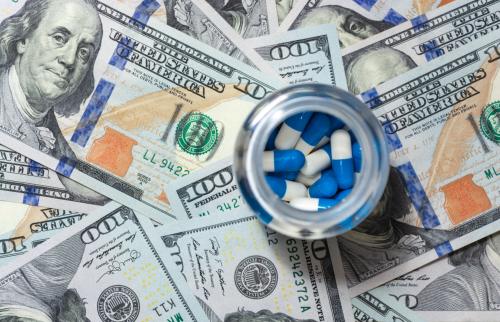The news Monday from the Centers for Disease Control and Prevention (CDC) on the incidence of resistant infections is disturbing but not surprising. CDC estimates that over two million Americans every year are affected by drug-resistant infections and of those, 23,000 die annually. The report notes that these figures are conservative and are likely an underestimate of the burden of resistant infections. While these numbers reflect domestic rates, antibiotic resistance is a global issue as well.
To further compound the issue, today’s antibiotic pipeline is nearly dry and has been for some time, with only a handful of large pharmaceutical companies and smaller biotech firms still engaged in antibiotic development. The threat of a so-called ‘post-antibiotic era’ – a time when there are no longer any effective antibiotic treatments – could become a reality without a concerted and comprehensive effort to combat this global threat. The evolution of drug resistance is an inherent risk of antibiotic use. The CDC report cited the development of new antibiotics and diagnostic tools, as well as programs and policies to support appropriate use of antibiotics, as being among the core strategies to combat resistance.
Clinical effectiveness and the relatively low cost of antibiotics have had the unintended consequence of contributing to overuse, accelerating the development of antibiotic resistance to all major classes of antibiotics. While there are some diagnostic tools available to support targeted treatment, it is often more time- and cost-effective for a physician to prescribe a relatively inexpensive, broad-spectrum antibiotic than to conduct a diagnostic test (if one exists at all). Antibiotic overuse can also be driven by patients who see antibiotics as safe and often low-cost cure-alls. Recognizing that these past patterns of overuse are dangerous, the clinical community is working diligently to curb inappropriate use and promote public health through stewardship and education programs. However, given the weakness of the current antibiotic development environment, it may be too little-too late; rates of resistance continue to rise globally while the number of effective therapies to treat many pathogens is dwindling. According to the CDC, resistance can be ”slowed but not stopped” – there will always be a need for novel antibiotics that can combat the evolution of these pathogens.
The current system for manufacturer return on investment for antibiotics, which are typically reimbursed at very low levels, is oriented towards volume sales. As a result, stewardship and educational programs geared toward limiting use of novel antibiotics create an ‘antibiotic development paradox.’ How can we incentivize investment in developing new effective antibiotics and also have successful programs that limit the use of these antibiotics in an effort to prevent or delay the development of resistance? Unless this fundamental conflict in the current business model is addressed, pharmaceutical firms are unlikely to expand development efforts.
How do we turn the tide?
There are several proposals that address aspects of the antibiotic development paradox with the goal of reinvigorating the antibiotic drug development ecosystem in a way that maximizes our ability to stay ahead of resistance. While none of these proposals alone will solve this problem, each could support the long-term goal of reinvigorating antibiotic discovery, development, and treatment.
Creating incentives for drug development
Antibiotic drug development has been a losing prospect for drug developers and has driven many of them to exit the antibiotic innovation space in the last few decades in favor of other therapeutic areas that have much larger markets and are easier areas to study. In order to make antibiotic development more attractive, various mechanisms have been proposed to stimulate or better reward successful clinical development. Incentives that can lower the financial risks associated with development include grants, tax credits, public-private partnerships, and intellectual property protections. Post-approval, prizes, advanced market commitments, and value-based pricing could all potentially provide additional incentives to invest in this research. Some potential incentives were discussed at the Incentives for Change: Addressing the Challenges in Antibacterial Drug Development workshop convened by Brookings in February 2013.
Balancing benefit and risk for severely-ill patients
Other incentives are related to the drug approval process. Novel mechanisms for expedited development and approval can speed time to market while still meeting traditional evidentiary requirements for safety and efficacy. In the last several years, a number of proposals – including from the Infectious Diseases Society of America and the President’s Council of Advisors on Science and Technology – have sought to reduce development time and cost and increase regulatory clarity through a more targeted clinical trial process directed at the highest-risk patients. A narrower study population would allow the U.S. Food and Drug Administration to make a more targeted assessment of the product’s safety, efficacy, and benefit-risk profile that could accelerate innovation for patients with serious drug-resistant infections. The need to steward these antibiotics, which was noted as a core action in the CDC report, would be especially important to both prevent the growth of resistance and to reduce the risk of adverse effects in less seriously-ill populations. Additional information on the proposed limited-use pathway and appropriate use is available on the Brookings website.
De-link reimbursement from return on investment
In order to attract investment for new antibiotic research, we must develop a business model that can support ongoing and expanding development without compromising the effectiveness of new therapies. Recognizing the need to “de-link” return on investment from the volume of antibiotics sold, efforts to move away from the volume-based reimbursement system could become an attractive path forward. Promising models, which were discussed at the Brookings workshop in February, included several guaranteed payment schemes supported by public funding. Taken to an extreme, such a system could even allow new antibiotics to be reserved indefinitely until needed, removing the developer’s incentive to sell any drugs in the years following approval. While such a program would likely be expensive (with sufficient returns estimated on the order of $1.75-2.5 billion over five years), government intervention is needed to fix this public health crisis and dangerous market failure. Its societal value in curtailing resistance and providing critical drugs would outweigh the cost to taxpayers.
The antibiotic development paradox will require a multi-pronged strategy that includes incentives to support front-end drug discovery and development, and new reimbursement policies that de-link unit volume sales from return on investment. However, this is by no means a quick fix. Even if this approach is successful, it will take decades for manufacturers to rebuild lost antibiotic development infrastructure and expertise, and to successfully develop and market new treatments. For the few drugs currently in development, even with expedited development and review pathways, they are still years from reaching the market.
The Brookings Institution is committed to quality, independence, and impact.
We are supported by a diverse array of funders. In line with our values and policies, each Brookings publication represents the sole views of its author(s).



Commentary
Antibiotic Development and Market Failure: No Quick Fix
September 20, 2013